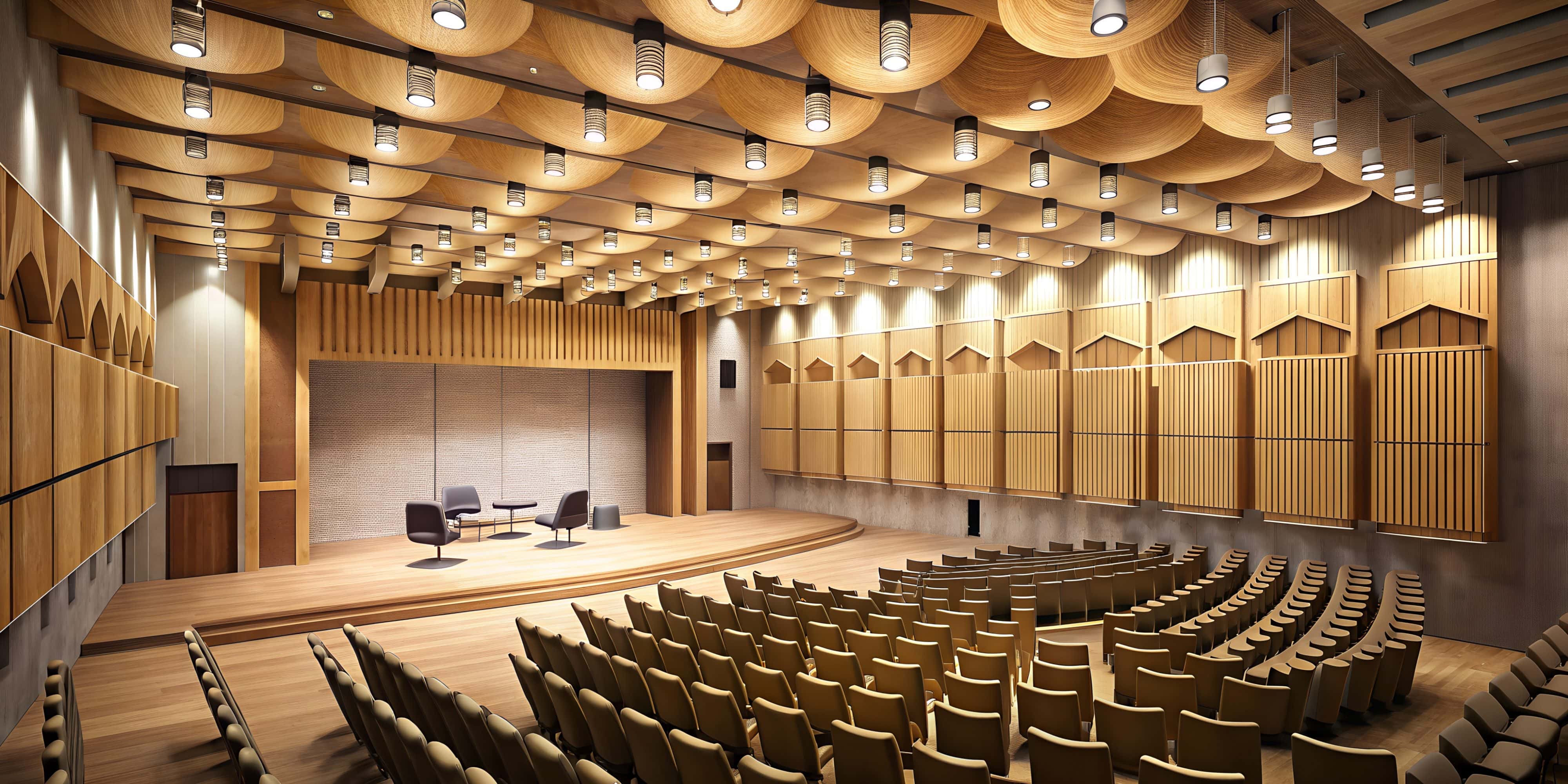Introduction: The Architectural Acoustic Panels Market Report
“You feel that your life is being lost in a room where sound dies,” Renzo Piano once remarked, underscoring the profound impact of acoustics on our perception of space. “We need reverberation,” he emphasised, pointing to the necessity of integrating sound considerations into architectural design. The market for architectural acoustic panels has seen a surge in popularity recently as companies delve deeper into the potential of these materials to enhance spatial acoustics while opening up new design possibilities. Through a detailed review of the 2024 market study, we will uncover where the market is headed, equipping industry players with crucial data to strategically steer their operations and adapt to emerging trends.
Download the report for yourself: https://www.precisionreports.co/enquiry/request-sample/21014348?

Historical Market Analysis (2018-2024)
The journey of the Architectural Acoustic Panels market from 2018 to 2024 was marked by significant fluctuations, pivotal developments, and a steady maturation in technologies and applications. This period was critical in setting the foundation for the robust growth trajectory we observe today.
Tracing the Growth Path
From 2018 to 2024, the architectural acoustic panels market experienced a compound annual growth rate (CAGR) that reflected the growing awareness of the importance of noise reduction in urban environments. The market’s evolution was driven by increasing urbanisation and the consequent demand for better living and working spaces. As cities grew denser, the clamour for acoustic comfort in residential, commercial, and industrial buildings heightened, propelling the demand for high-quality acoustic solutions.
Key Developments and Innovations
During this period, the industry saw several innovations that dramatically enhanced the efficacy and aesthetic appeal of acoustic panels. Manufacturers like Armstrong and Saint-Gobain introduced panels that not only excelled in sound absorption but also blended seamlessly with modern interior designs. These innovations were not just about functionality; they redefined what architects and builders could achieve in terms of aesthetics.
Market Dynamics
The timeline from 2018 to 2024 was also characterised by strategic alliances and mergers, which were aimed at consolidation and expanding geographical reach. Companies like STAR-USG and Beijing New Building Material were at the forefront, leveraging partnerships to innovate and capture larger market shares.
The Role of Regulations
Government regulations regarding building codes also played a crucial role in this period. Stricter norms were introduced for acoustic standards in buildings, especially in regions like Europe and North America, which mandated the incorporation of high-performance acoustic materials, thus giving a significant push to the market.
Expert Insights
Reflecting on the trends, an industry expert from Knauf Insulation commented, “The period between 2018 and 2024 was transformative. We saw a shift not only in the technologies used but also in how stakeholders perceived soundscapes within architectural designs. It was no longer about just adding panels; it was about integrating acoustics into the very essence of architectural planning.”
This historical perspective sets the stage for understanding the current dynamics and future potentials of the Architectural Acoustic Panels market. The lessons learned and the groundwork laid during these formative years are invaluable as we look ahead to more innovative and sustainable acoustic solutions.
Market Forecast (2024-2032)
As we look towards 2024 and beyond, the Architectural Acoustic Panels market is poised for significant evolution. This section outlines the anticipated changes, the driving forces behind them, and the potential market scenarios that stakeholders may need to navigate through.
Anticipated Growth and Trends
The market is expected to witness a robust CAGR from 2024 to 2032, driven by the increasing demand for soundproofing solutions across various sectors, including residential, commercial, and industrial. The trend towards greener and more sustainable building practices is also expected to boost the demand for eco-friendly acoustic panels, making this a key area of development.
Innovations on the Horizon
Technological advancements are set to revolutionise the types and functionalities of acoustic panels, with tech startups and established companies like Armstrong and Knauf Insulation at the forefront of this innovation. Collaborating with research institutions and universities, these industry leaders are developing smart acoustic panels that are equipped with sensors and connectivity technology. This allows the panels to analyse and respond to the acoustic environment in real time, adjusting properties such as density or absorption coefficients to optimise sound quality and reduce noise levels dynamically.
Development of this technology is happening globally, with significant research and testing taking place in tech hubs like Silicon Valley in the United States, as well as tech-centric cities in Europe and Asia, including Berlin and Tokyo. Manufacturing and prototyping of these panels often occur close to these research centres to facilitate seamless integration of R&D and production.
These innovative panels are expected to gradually enter the market over the next few years, with initial prototypes and pilot projects potentially appearing as early as 2025. Broader commercial availability and adoption are anticipated by the end of the decade.
Imagine a bustling school located near a busy street, where the auditorium is equipped with these smart acoustic panels. During a loud music concert, the panels can increase their sound absorption to manage decibel levels effectively. Conversely, during a quiet lecture, they can fine-tune the environment to enhance speech clarity and reduce external noise interference. This dynamic adjustment ensures optimal acoustic conditions tailored to each specific use case, enhancing the auditory experience for all users within the space.
Emerging Market Dynamics
The market dynamics are anticipated to shift with the Asia-Pacific region, which is projected to lead in terms of growth due to rapid urbanisation and industrialisation, especially in countries like China and India. North America and Europe will continue to see steady growth, fueled by renovations in older buildings and stringent regulations for noise control.
Potential Challenges and Opportunities
One potential challenge could be the fluctuating raw material prices, which may impact the manufacturing costs of acoustic panels. However, this could also drive the innovation of more cost-effective materials and production techniques. Additionally, the increasing awareness of mental health issues related to noise pollution could open up new markets for advanced acoustic solutions in settings such as schools, hospitals, and offices.
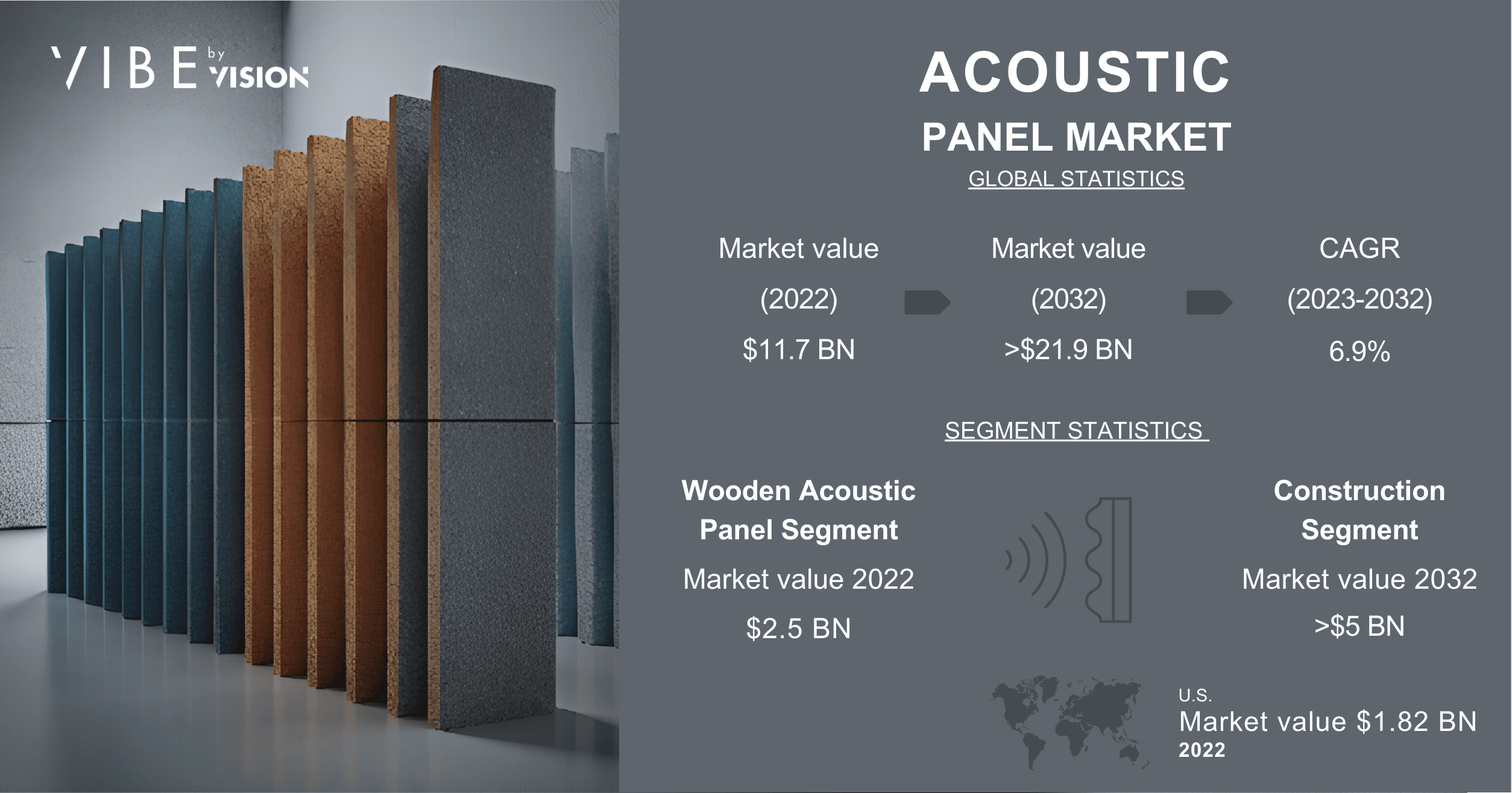
Detailed Product Type Analysis
Mineral Wool Acoustic Panels
Mineral wool acoustic panels are renowned for their excellent sound absorption properties and safety features. In light of the Architectural Acoustic Panels Market Report, these panels continue to see robust demand, particularly in industrial settings, due to their fire resistance and sound-dampening capabilities. The market forecast suggests a steady growth trajectory driven by stricter building regulations and increased construction activities.
SWOT Analysis
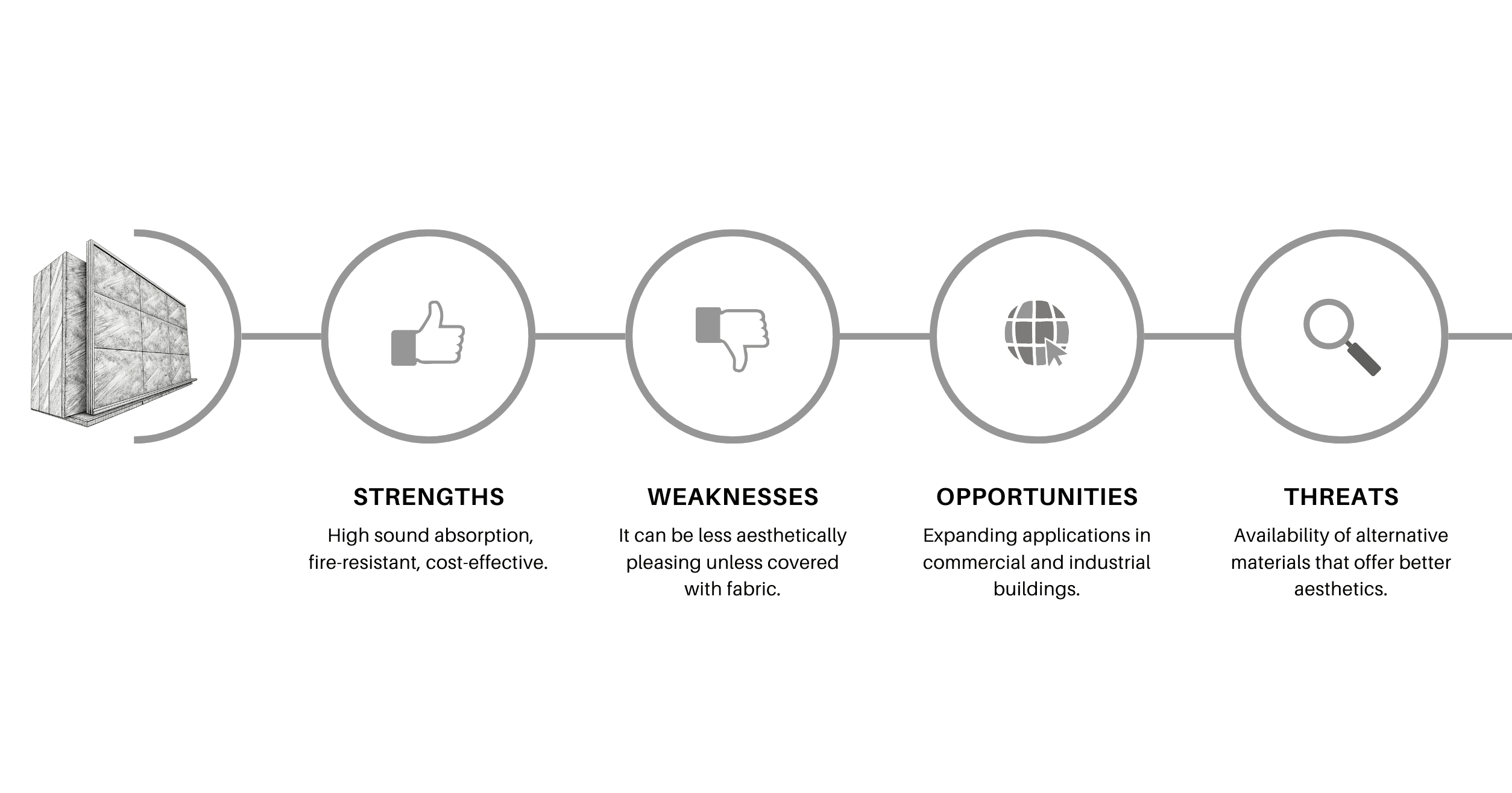
Wooden Acoustic Panels
Wooden panels are not just acoustically effective but also aesthetically pleasing, making them popular in sectors like hospitality and residential construction. According to the market report, the demand for wooden acoustic panels is expected to grow, particularly with the rising trend of eco-friendly and visually appealing interior designs.
SWOT Analysis
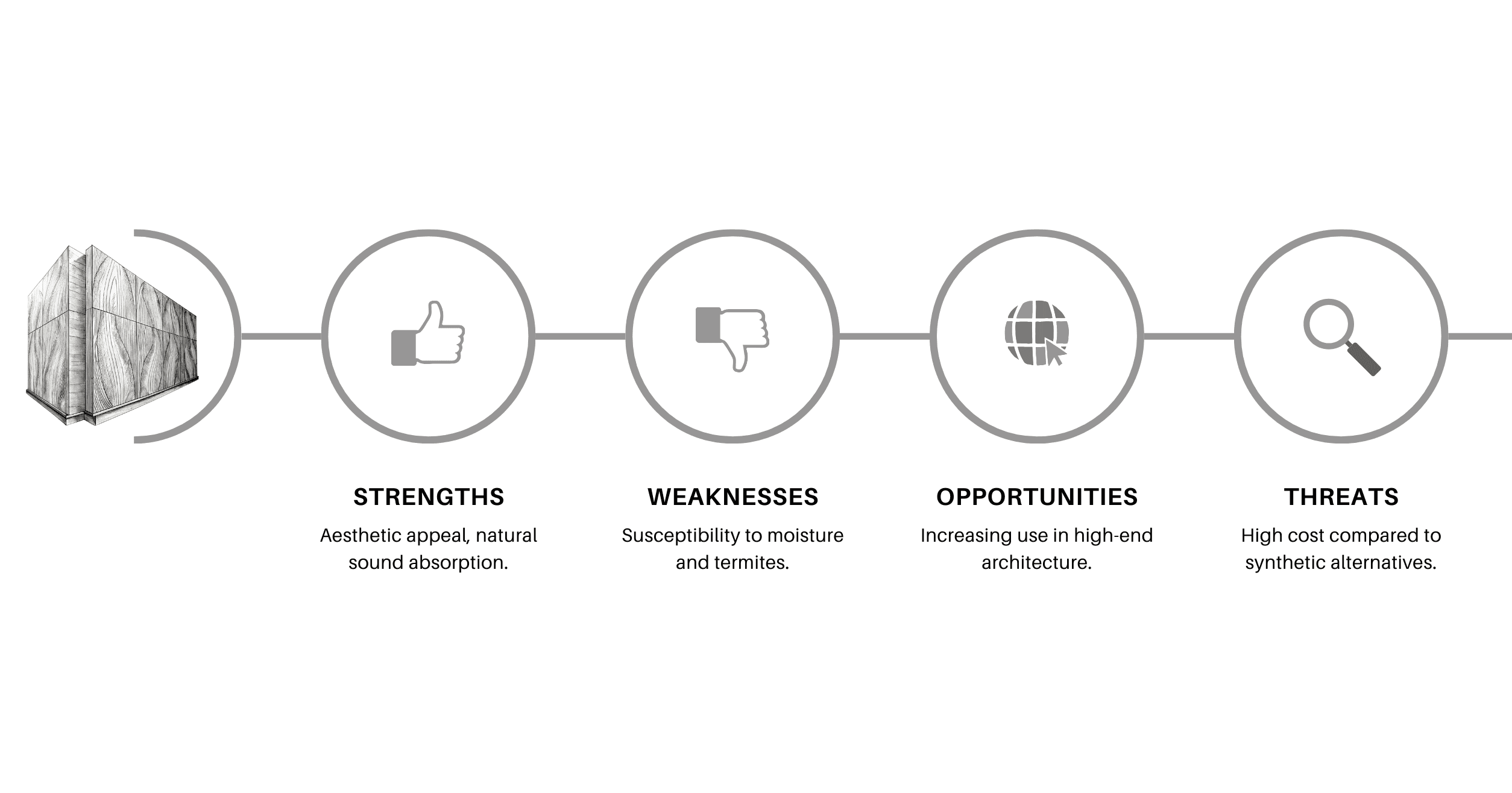
Fabric Acoustic Panels
Fabric panels are favoured for their versatility and design flexibility, which makes them ideal for theatres and luxury venues. The market analysis indicates that with the ongoing innovation in fabric technologies, these panels will continue to evolve, potentially opening up more bespoke and high-performance applications.
SWOT Analysis
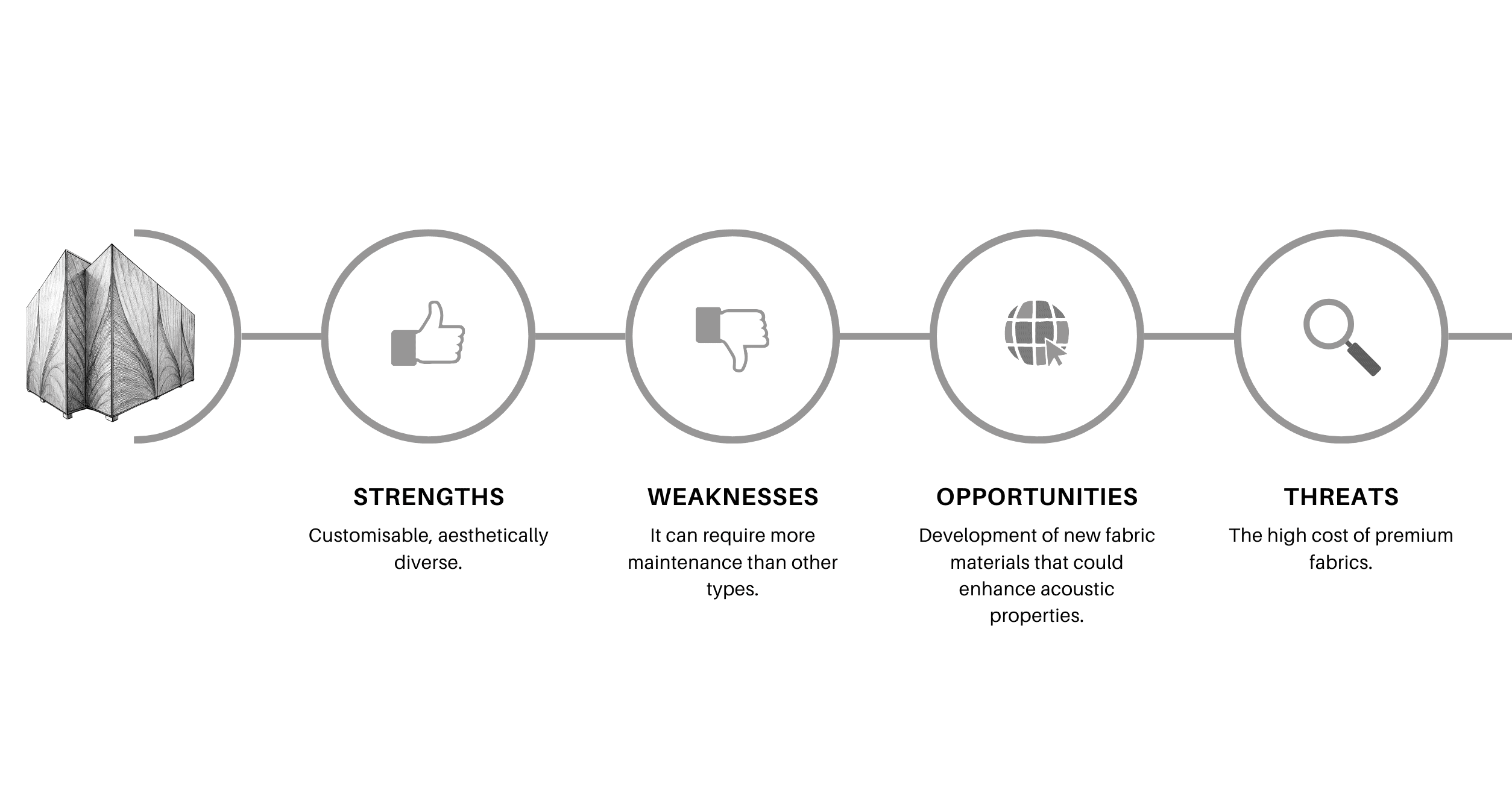
Polyester Acoustic Panels
Polyester panels are celebrated for their durability and environmental sustainability. The market forecast is optimistic, particularly as there is an increasing shift towards sustainable building materials. These panels are expected to gain a larger market share, especially in environments that require rugged, moisture-resistant solutions.
SWOT Analysis
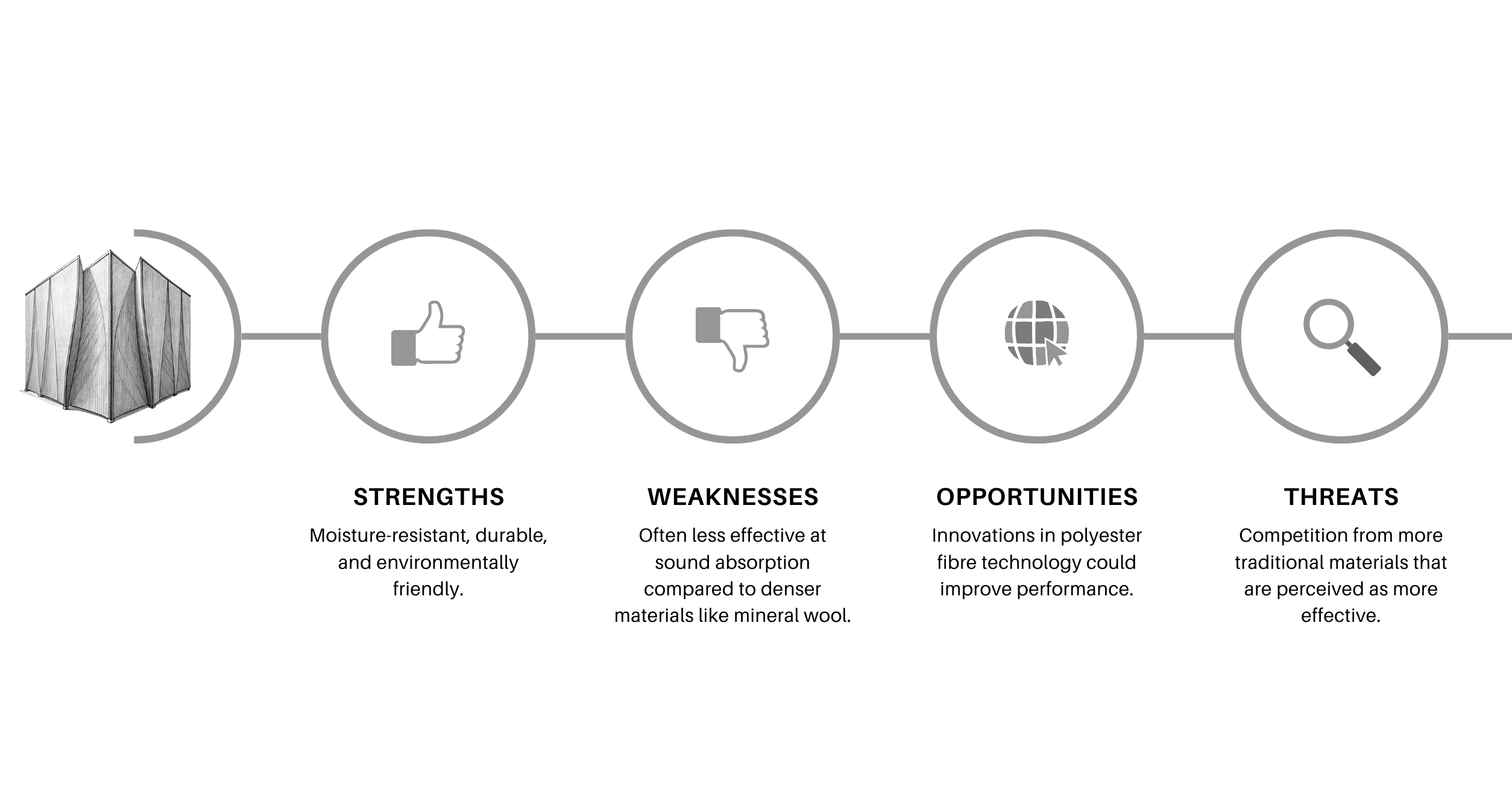
Custom Acoustic Panels
Custom acoustic wall and ceiling panels are tailored solutions designed to meet specific acoustic challenges of buildings. The market report underscores their growing installation in commercial buildings and educational institutions. These panels are forecasted to see significant growth as more buildings are designed with acoustic comfort in mind.
Each panel type presents its unique set of advantages and challenges, but overall, the market’s growth prospects look promising across all segments. Continued innovation and a deeper understanding of acoustic needs in modern architecture are likely to drive further development and adoption of these solutions.

Regional Market Insights
The Architectural Acoustic Panels market showcases a varied landscape across different regions, influenced by local building practices, economic dynamics, and cultural preferences. Here’s a closer look at how these panels are being adopted across key geographic areas.
North America
In North America, the focus on creating quieter and more productive work environments has significantly driven the adoption of acoustic panels. The U.S. and Canada have seen robust growth in the market, supported by stringent regulations on building noise levels and a strong preference for sustainable building materials. “The demand for acoustic solutions in North America has grown exponentially as more businesses recognise the productivity benefits of sound-controlled environments,” states a leading analyst from a New York-based market research firm.
Europe
Europe’s market is characterised by high demand for eco-friendly and high-performance acoustic solutions, particularly in countries like Germany, the UK, and France. The region’s stringent building standards for noise reduction, combined with a high rate of renovations in older buildings, continue to sustain the demand for acoustic panels. “In Europe, there’s a deep appreciation for both the functional and aesthetic qualities of acoustic panels, which has fostered a market rich with innovative, design-forward solutions,” mentions a London-based architect.
Asia-Pacific
The Asia-Pacific region represents the fastest-growing market, with countries like China, India, and Japan at the forefront of this surge. Rapid urbanisation, expanding infrastructure, and increasing awareness of acoustic comfort are key drivers. “Asia-Pacific’s boom in construction and architectural development presents vast opportunities for acoustic panel manufacturers,” says a market expert from Beijing. The region’s varied climate conditions also influence the demand for specialised products, like moisture-resistant panels in tropical areas.
Latin America
Latin America’s market is emerging, with steady growth noted in urban areas where noise pollution is becoming a significant concern. Countries like Brazil and Mexico are slowly adopting modern building techniques that incorporate acoustic solutions. “As urban centres in Latin America continue to grow, so does the awareness of the impacts of noise on health and well-being, which is gradually pushing the demand for acoustic panels,” notes a São Paulo-based urban planner.
Middle East and Africa
In the Middle East and Africa, the market is still nascent but promising, driven by massive infrastructure developments and an increasing number of luxury projects that emphasize optimal acoustic environments. “The Middle East is embracing high-end, technologically advanced acoustic solutions for its sprawling new developments, from commercial hubs to luxury residences,” explains a Dubai-based developer.
Cultural and Regional Preferences
Cultural preferences play a crucial role in the adoption of acoustic panels. For instance, in Asia, there is a significant emphasis on aesthetically pleasing designs that align with local tastes, while in North America, the focus might be more on functionality and sustainability. Understanding these nuances is key for manufacturers and suppliers aiming to penetrate these diverse markets effectively.

Impact of Technological Advancements on Architectural Acoustic Panels
The advancements in the architectural acoustic panels market are profoundly influenced by ongoing research and development efforts, as highlighted in the latest Architectural Acoustic Panels Market Report.
Innovations in Material Science
The shift towards sustainable material solutions in acoustic panels is exemplified by the development of bio-based panels. Organisations like the Building Research Establishment (BRE) in the UK have conducted extensive testing on panels made from natural fibres such as hemp and flax. Their studies show these materials not only meet but often exceed traditional performance metrics while offering significant environmental benefits. The use of such materials is gaining traction, especially within the European market, driven by the region’s stringent sustainability regulations.
Advances in Manufacturing Processes
Technological innovations in manufacturing are showcased by the implementation of 3D printing techniques. Companies like AcoustiTech, based in Germany, have pioneered the use of this technology to create highly customised acoustic solutions that reduce production waste and offer enhanced performance characteristics. Their case studies in commercial buildings across Berlin demonstrate how 3D-printed panels can be effectively used to tailor acoustic environments for specific applications, improving both aesthetics and functionality.
Revolutionary Design Techniques
The integration of smart technologies into acoustic panels is spearheaded by firms like SmartAcoustics, a Silicon Valley-based startup that collaborates with major tech firms such as Google and Apple. Their smart panels, equipped with sensors and adaptive controls, automatically adjust to environmental sounds, optimising acoustic environments in real time. A case study conducted in Apple’s corporate offices showed a significant improvement in reducing echo and enhancing speech clarity in open-plan offices using these smart panels.
The Evolution of Acoustic Panels
The evolution from basic noise control solutions to advanced, integrated systems is well documented by institutions such as the Massachusetts Institute of Technology (MIT). Their research into acoustic metamaterials offers insights into the future of architectural acoustics, with prototypes demonstrating the potential to completely block sounds of certain frequencies while allowing others to pass through, paving the way for highly selective noise control environments.
Future Directions
Looking forward, the interaction between emerging materials, advanced manufacturing processes, and innovative design techniques is expected to transform how buildings are constructed and renovated. The Global Building Network (GBN), along with academic partners such as MIT and commercial leaders like SmartAcoustics, continues to explore these intersections, providing forecasts and analyses that predict a more adaptive and responsive approach to architectural design that incorporates these cutting-edge acoustic solutions.
Sustainability and Environmental Impact
The architectural acoustic panels industry is increasingly focused on sustainability, responding to global environmental concerns and specific regulatory pressures, including those found in Ireland. This commitment is reshaping how products are designed, manufactured, and disposed of, aligning with broader goals of reducing environmental footprints.
Eco-Friendly Materials and Practices
Manufacturers are turning to sustainable materials that reduce environmental impact without compromising acoustic performance. This shift includes the use of recycled materials, such as recycled polyester, which is not only effective in sound absorption but also supports the circular economy by reducing landfill waste. Companies like EcoSound, based in the UK, have pioneered the use of such materials, offering a range of panels that meet both aesthetic and functional needs while being fully recyclable at the end of their life cycle.
Regulations Driving Change
In Ireland, strict building regulations and standards have been a significant driver for the adoption of sustainable practices in the construction industry, including acoustic panels. Irish Building Regulations, specifically Part E – Sound, mandate the levels of sound insulation necessary to ensure privacy and comfort in buildings. These regulations encourage the use of innovative materials and technologies that meet higher environmental standards. Additionally, Ireland’s commitment to the EU Green Deal further compels manufacturers to focus on reducing the carbon footprint of their products.
Manufacturing Innovations
Technological innovations in manufacturing processes are also contributing to environmental sustainability. Advanced manufacturing techniques such as digital fabrication and precision cutting reduce material waste significantly. For example, Dublin-based AcoustiTech utilises computer-aided design (CAD) and computer-aided manufacturing (CAM) to optimise material usage and minimise offcuts, which are recycled in-house, further lessening the environmental impact.
Life Cycle Assessment
More companies are conducting Life Cycle Assessments (LCAs) to evaluate the environmental impact of their acoustic panels from cradle to grave. These assessments help identify areas for improvement, from reducing energy consumption during production to enhancing the recyclability of panels. Such comprehensive evaluations align with global sustainability trends and regulatory expectations, ensuring that products are environmentally friendly throughout their lifespan.
Conclusion
In conclusion, the “Architectural Acoustic Panels Market” Research Report 2024 thoroughly explores the market across 115+ pages, offering detailed insights into the trends, statistics, and competitive dynamics of this niche sector. The report covers a historical analysis from 2018-2024 and projects forward to 2032, identifying key trends and potential shifts in the types and applications of acoustic panels across diverse regions. With a steady growth predicted and a significant CAGR anticipated from 2024 to 2032, the market is poised for transformative development, influenced by technological advancements and evolving regulatory landscapes.
The detailed segmentation of the market into types such as mineral wool, wooden, fabric, and polyester acoustic panels, alongside applications in residential, commercial, and industrial buildings, provides stakeholders with a comprehensive understanding of the market dynamics. Key global players like STAR-USG, Armstrong, and Saint-Gobain are highlighted as major contributors to the market’s growth, ensuring a competitive and innovative market environment.
This analysis underscores the importance of strategic planning and adopting advanced manufacturing techniques and sustainable practices, which are crucial for staying competitive in this growing industry. The regional insights confirm the Asia-Pacific as the leading market, with significant contributions also coming from North America and Europe, driven by both technological adoption and stringent environmental regulations.
Overall, the Architectural Acoustic Panels Market is set to continue its growth trajectory, fueled by increased global demand and technological innovations that offer promising opportunities for industry players. The report serves as a vital resource for anyone looking to understand the market’s intricacies and strategise effectively for the future.
